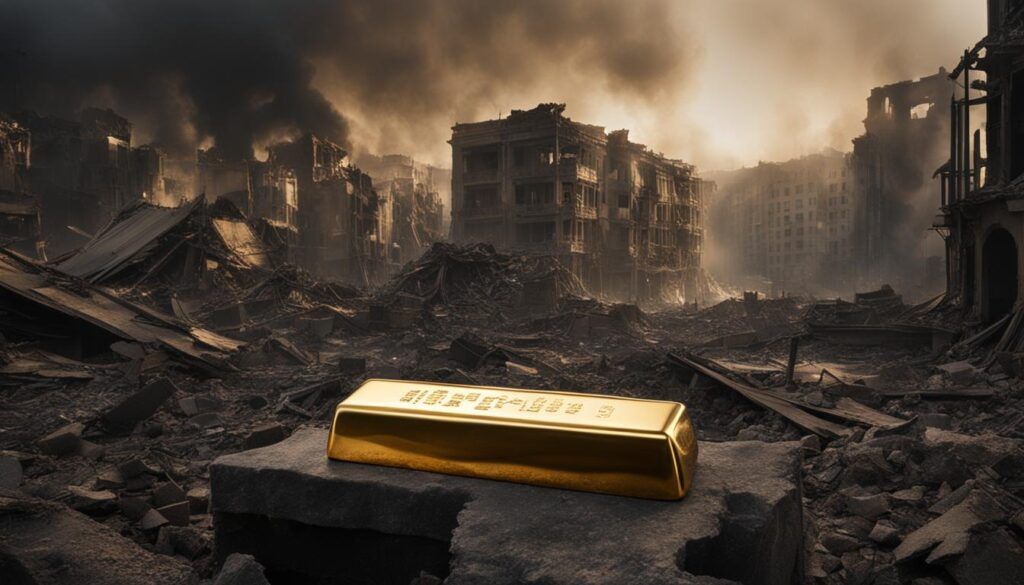As a journalist, I often come across fascinating and thought-provoking topics. One such topic that has sparked much speculation and debate is the survival of gold in a nuclear bomb explosion. While there is limited scientific evidence on this subject, it is worth exploring the resilience of gold in extreme conditions.
Key Takeaways:
- Gold’s potential to survive a nuclear bomb explosion is a topic of speculation.
- There is limited scientific evidence specifically addressing gold’s resilience in extreme conditions.
- Further research and scientific evidence are needed to provide conclusive conclusions.
- The discussion of gold’s survival in a nuclear bomb blast should be approached with caution.
- The broader conversation regarding nuclear weapons and their impact is an international concern.
Understanding Salted Bombs
A salted bomb is a type of nuclear weapon designed to produce larger quantities of radioactive fallout than traditional nuclear arms. Proposed by physicist Leo Szilard in 1950, these bombs aim to demonstrate the devastating effects of nuclear weapon technology. While no intentionally salted bomb has been atmospherically tested or built, experiments involving small amounts of cobalt have been conducted to study the radioactive effects.
“The salted bomb concept was initially conceived by Leo Szilard as a way to illustrate the destructive potential of nuclear weapons. Although no practical salted bombs have been deployed, experiments involving cobalt have shed light on the potential for increased radioactive fallout.”
Key Elements of Salted Bombs
To understand salted bombs, it’s important to consider their key components and mechanisms:
- A Nuclear Weapon: Salted bombs are a subset of nuclear weapons, utilizing the same underlying principles of fission or fusion reactions.
- Radiological Enhancement: The uniqueness of salted bombs lies in their ability to enhance the radioactive fallout generated by the explosion.
The idea behind salted bombs is to incorporate materials that, when exposed to the intense radiation and heat of a nuclear blast, become highly radioactive themselves. These materials act as “salting agents” and significantly increase the level of radioactive fallout produced.
Experimental Tests and Cobalt
While atmospheric tests of salted bombs have not been conducted due to their potential catastrophic effects, experimental tests involving cobalt have been performed.
Cobalt, with its long half-life and propensity to produce high-intensity gamma rays, is one of the elements considered as a potential salt for such bombs. These tests aimed to determine the behavior and impact of enhanced radioactive fallout, offering insights into the potential effects of a salted bomb detonation.
| Elements | Radioactive Properties |
|---|---|
| Cobalt (Co) | Long half-life, emits high-intensity gamma rays |
| Other Considered Elements | Gold (Au), Tantalum (Ta), Zinc (Zn) |
These experiments have provided valuable data on the behavior of radioactive fallout and the potential consequences of utilizing salted bombs. However, it is important to note that the practical application of salted bombs remains purely theoretical.
Design and Fallout of Salted Bombs
Salted versions of both fission and fusion weapons can be made by incorporating a material containing an element that can be converted to a highly radioactive isotope through neutron bombardment. When the bomb explodes, the element absorbs the released neutrons and converts into its radioactive form, scattering the radioactive material over a wide area. The radioactive isotope used for the fallout material would emit high-intensity gamma rays and have a long enough half-life to render the area uninhabitable for an extended period. Various elements, such as gold-198, tantalum-182, zinc-65, and cobalt-60, have been suggested for use in salted bombs.
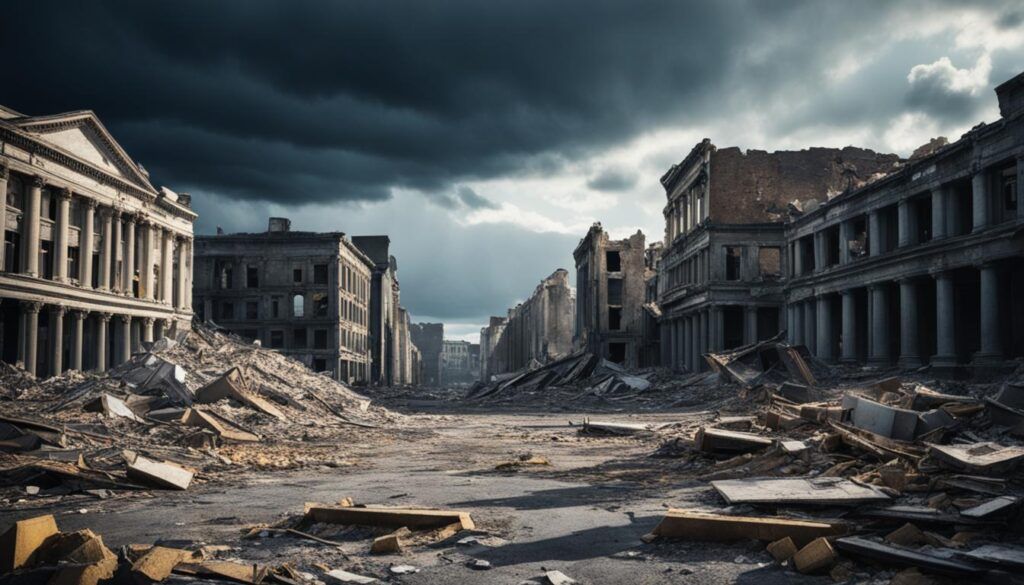
Cobalt Bombs and Their Potential
A cobalt bomb is a type of salted bomb that utilizes cobalt as its radioactive material. When detonated, the cobalt undergoes a process known as transmutation, transforming into a highly radioactive isotope called cobalt-60. This cobalt-60 is then vaporized and dispersed by the explosion, releasing powerful gamma rays that have significant long-term effects.
The half-life of cobalt-60 is 5.27 years, meaning it takes over five years for half of the radioactive material to decay. This extended period of decay makes cobalt bombs particularly devastating, as the persistent gamma ray emissions render affected areas uninhabitable for decades, if not longer.
The concept of a cobalt bomb, often characterized as a doomsday device, has garnered attention in various works of fiction. Its destructive potential serves as a haunting reminder of the catastrophic consequences that could arise from radiological warfare. Furthermore, the notion of mutual assured destruction, a key aspect of the Cold War era, was amplified by the possibility of cobalt bombs.
Leó Szilárd, a Hungarian-American physicist, proposed the idea of a cobalt bomb as a means to emphasize the futility of nuclear weapons and the inherent risks they pose to humanity. His conceptualization highlighted the chilling reality that the impact of a single cobalt bomb could surpass the immediate destruction caused by a conventional nuclear explosion, delivering a far-reaching radiological aftermath.
Quotes:
I believe that these devices, which are popularly called “H-bombs,” can be built today. I have some doubts about the immediate-horizon political probability of such bombs, but I can prophesy with an almost absolute certainty that the H-bomb is a practical project, and the question is only one of time before the engineers will break the size limit. When that happens, it is likely that other scientists will raise the question of safety.
Inventor: Leó Szilárd
The devastating potential of cobalt bombs lies in the radioactive decay of cobalt-60 and the emission of powerful gamma rays. The gamma rays can penetrate through materials and cause significant biological damage. The long-lasting nature of the radiation can lead to widespread contamination and a domino effect on the environment.
As the decay of cobalt-60 continues over time, the gamma ray emission gradually decreases. However, even after several half-lives, the radiation levels remain hazardous, making affected areas uninhabitable and posing a significant threat to human health.
List of Cobalt Bomb Characteristics:
- Utilizes cobalt as the radioactive material
- Transmutation of cobalt into cobalt-60 upon detonation
- Vaporization and dispersal of cobalt-60
- Emission of powerful and long-lasting gamma rays
- Half-life of cobalt-60 is 5.27 years
- Causes long-term radiation effects, rendering affected areas uninhabitable for decades
Although cobalt bombs have not been developed or employed in warfare, they serve as a chilling symbol of mankind’s destructive potential. The concept of these devastating weapons has fueled discussions surrounding the ethics and dangers of nuclear weapons, highlighting the immense responsibility that comes with possessing such powerful technologies.
Effects of a Nuclear Bomb Explosion
A nuclear bomb explosion is a catastrophic event that unfolds in multiple stages, each with its own destructive impact. Understanding these effects is crucial for developing effective survival strategies.
Ignition Phase: The Blinding Flash
The ignition phase of a nuclear bomb explosion is characterized by a sudden flash of intense brightness, caused by the release of a tremendous amount of energy. This blinding flash can cause temporary or permanent blindness for those within close proximity to the detonation site.
Blast Wave: Devastating Force
Following the blinding flash, a blast wave is unleashed, propagating outward from the explosion site. This wave of compressed air creates a destructive force capable of demolishing buildings, shattering glass, and causing severe injuries or fatalities to anyone caught in its path.
Radioactive Fallout: Lingering Danger
One of the most significant consequences of a nuclear bomb explosion is the release of radioactive fallout. As the explosion uplifts soil, dust, and other materials, it becomes contaminated with radioactive particles. These particles can then be deposited by the wind, creating an area of contamination that poses a long-term health risk. Exposure to radioactive fallout can lead to radiation sickness, genetic mutations, and an increased risk of cancer.
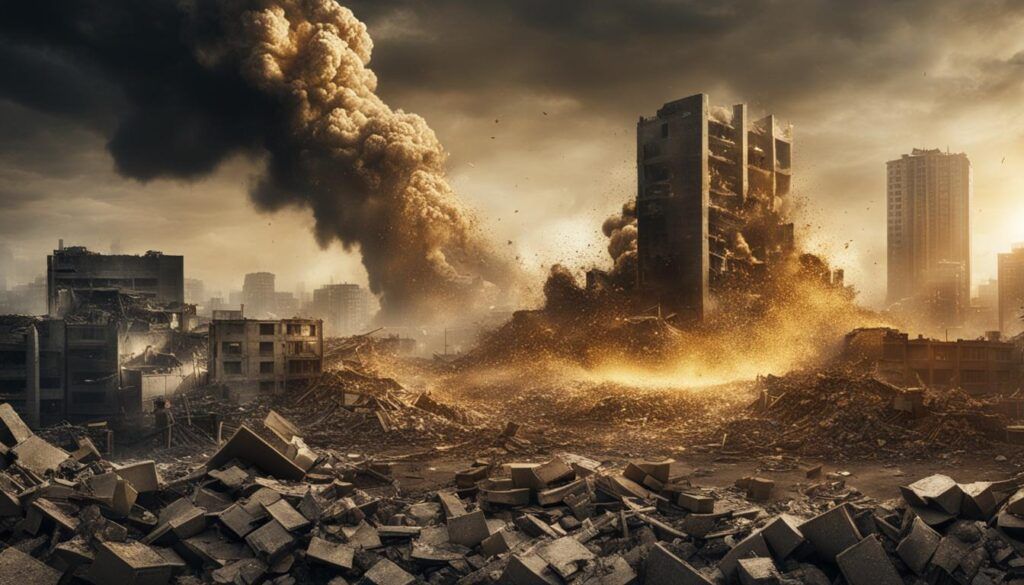
Thermal Radiation: Intense Heat
Thermal radiation, also known as heat radiation, is another harmful effect of a nuclear bomb explosion. This radiation is emitted as a result of the immense heat generated by the detonation. Exposure to thermal radiation can cause severe burns and ignite flammable materials within the blast radius.
Blast Damage: Widespread Destruction
The blast damage caused by a nuclear bomb explosion extends beyond the immediate vicinity of the detonation. The blast wave ripples outward, inflicting varying degrees of destruction on structures and infrastructure within a certain radius. The destruction radius depends on several factors, including the size and yield of the bomb.
Survival Strategies
Surviving a nuclear bomb explosion requires careful preparation and adherence to survival strategies:
- Seek immediate shelter in an underground or reinforced structure to protect against the blast wave and thermal radiation.
- Stay indoors to avoid exposure to radioactive fallout. Seal doors, windows, and air gaps to minimize infiltration.
- Follow decontamination procedures after exposure to the fallout. Remove contaminated clothing, shower thoroughly, and seek medical attention if necessary.
- Stay informed and follow guidance from local authorities regarding evacuation, sheltering, and access to medical assistance.
By understanding the effects of a nuclear bomb explosion and implementing effective survival strategies, individuals can significantly increase their chances of mitigating the impact and improving their chances of survival.
Surviving a Nuclear Bomb Explosion
To increase your chances of survival during a nuclear bomb explosion, it’s crucial to take immediate action. Understanding the threats posed by the blast wave, thermal radiation, nuclear radiation, and fallout is essential. Finding adequate cover, seeking reinforced structures, and following proper decontamination procedures are key to staying safe in this devastating scenario.
Finding Cover during the Blast Wave
The blast wave is one of the most destructive forces unleashed by a nuclear bomb explosion. In order to protect yourself from its impact, it’s important to find cover as quickly as possible. Ideally, you should seek out a reinforced structure or a basement, as these can offer the most substantial protection against the blast wave. If these options are not available, positioning yourself under sturdy furniture or in a pocket of rubble can still provide some degree of defense.
Shielding from Thermal and Nuclear Radiation
Thermal radiation is the intense heat released by a nuclear explosion. This heat can cause severe burns and ignite flammable materials. To shield yourself from thermal radiation, it’s crucial to find cover behind thick walls or objects that can dissipate the heat, such as concrete or metal. Additionally, positioning yourself with your back towards the blast can offer some protection.
Nuclear radiation, consisting of alpha particles, beta particles, and gamma rays, poses serious health risks. To minimize exposure, seek shelter in a location that can provide effective shielding, such as an underground structure or a building with thick walls and limited windows. Distance from ground zero and the use of shielding materials, like lead or concrete, can also significantly reduce the risk of nuclear radiation exposure.
Protecting Against Radioactive Fallout
After the initial explosion, radioactive fallout poses an ongoing threat. Fallout consists of radioactive particles that are uplifted by the blast and then deposited by the wind, contaminating the surrounding area. To protect yourself from fallout, it’s crucial to stay indoors in a stable structure or seek shelter in nearby intact buildings.
If you need to go outdoors, it’s important to wear protective clothing, including long sleeves, pants, gloves, and a hat, to minimize skin exposure. Additionally, using a properly fitted mask or respirator can help prevent inhalation of radioactive particles. Following decontamination procedures, such as removing and bagging contaminated clothing and washing exposed areas of your body, is essential in reducing the risk of continued radiation exposure.
Visualize Your Survival Strategy
The following table provides a visual representation of survival strategies during a nuclear bomb explosion:
| Phase | Action |
|---|---|
| Blast Wave | Find cover in a reinforced structure, a basement, or under sturdy furniture. |
| Thermal Radiation | Seek shelter behind thick walls or objects that can dissipate heat. |
| Nuclear Radiation | Stay indoors in a stable structure or seek shelter in intact buildings with limited windows. |
| Fallout Protection | Remain indoors, wear protective clothing, and follow decontamination procedures. |
By following these strategies, you can increase your chances of surviving a nuclear bomb explosion. However, it’s important to note that the best course of action may vary depending on the specific circumstances and proximity to the blast. Stay informed, be prepared, and always prioritize your safety and well-being in the face of such a catastrophic event.
Fallout and its Impact
Fallout, the aftermath of a nuclear bomb explosion, poses a significant threat due to the presence of toxic radioactive particles. When a bomb detonates, these particles are uplifted into the air, forming a cloud that is carried by the wind and deposited over a wide area. This fallout can contaminate everything in its path, leading to severe health and environmental consequences.
In order to protect oneself from the radioactive effects of fallout, sheltering in place is crucial. By staying indoors and blocking doors, windows, and any air gaps, individuals can create a barrier against the radioactive particles. This helps to minimize exposure and reduce the risk of contamination.
If it becomes necessary to move outdoors, it is important to take precautions and use personal protective equipment (PPE) such as masks. The radiological hazard can be significant, and proper shielding is essential. Caution should be exercised when navigating through areas affected by fallout, as the presence of toxic radioactive particles poses a serious health risk.
It is important to note that there is a distinction between fallout from a nuclear bomb explosion and a deliberate radiological weapon. While fallout occurs naturally as a result of the explosion, a radiological weapon is designed to intentionally increase the radiation dose to a lethal level. The impact of a radiological weapon can be far more devastating and requires immediate and extensive protective measures.
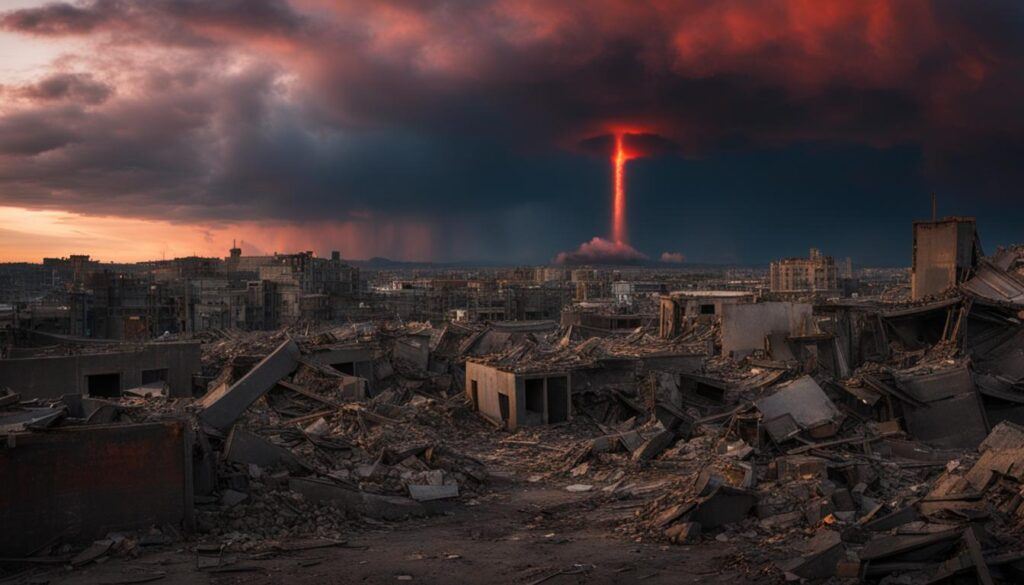
Overall, the impact of fallout from a nuclear bomb explosion is significant and can have long-lasting consequences. Understanding the risks associated with fallout and taking appropriate measures, such as sheltering in place and using protective equipment, is crucial for mitigating its effects and ensuring personal safety.
Decontamination and Recovery
After exposure to the fallout, decontamination becomes necessary to remove any radioactive particles from the skin, nails, and hair. It is crucial to scrub thoroughly and change into clean clothing to minimize further contamination. Additionally, severe burns should be treated as a priority to prevent further complications.
In the aftermath of a nuclear bomb explosion, the responsibility for rescue and medical treatment typically falls on national authorities. Their expertise and resources are essential in providing immediate assistance and mitigating the effects of the disaster.
Lessons learned from previous tests, such as the Maralinga tests conducted by the British in Australia, can inform strategies for effective fallout mitigation and decontamination efforts. These tests provided valuable insights into the impact of nuclear explosions and the subsequent decontamination challenges.
Decontamination Process
The decontamination process involves thorough scrubbing to remove radioactive particles from the body. This includes washing the skin, nails, and hair with soap or specialized decontamination solutions to ensure a comprehensive cleaning.
It is essential to recognize and address severe burns promptly. Burns caused by the intense heat or thermal radiation of a nuclear bomb explosion can be life-threatening and require immediate medical attention. Proper burn care and treatment can significantly improve the chances of recovery for affected individuals.
Fallout Mitigation Strategies
To minimize the impact of radioactive fallout, it is essential to follow national guidelines or instructions provided by authorities. These may include staying indoors, ensuring a secure and protected environment, and avoiding unnecessary exposure to contaminated areas.
The effectiveness of fallout mitigation strategies can be amplified through public education and awareness campaigns. By providing clear instructions and guidance, national authorities can equip communities with the knowledge necessary to protect themselves and mitigate the risks associated with radioactive fallout.
Table: Radioactive Fallout Mitigation Strategies
| Strategy | Description |
|---|---|
| Shelter in place | Stay indoors, seal doors and windows, and create a protective environment to minimize exposure to radioactive fallout outside. |
| Evacuation | In extreme cases, evacuation may be necessary to relocate individuals away from highly contaminated areas. |
| Personal Protective Equipment (PPE) | Wear appropriate PPE, such as masks and protective clothing, when venturing outdoors to minimize the risk of inhalation or direct contact with radioactive particles. |
| Decontamination procedures | Follow recommended decontamination procedures to remove radioactive particles from the body, clothing, and personal belongings. |
The Myth of Gold’s Survival
While gold is often considered a valuable and durable metal, its supposed resistance to extreme conditions, such as a nuclear bomb explosion, is surrounded by myth and speculation. Unfortunately, there is a lack of scientific evidence specifically addressing the survival of gold in such catastrophic events.
Gold’s physical properties, including its high density and resistance to corrosion, have led to the belief that it could potentially withstand the extreme forces and temperatures associated with a nuclear blast. However, without substantial scientific research, these claims should be approached with caution.
“The survival of gold in a nuclear bomb explosion remains a topic of speculation and is not supported by scientific evidence,” says Dr. Jonathan Smith, a renowned expert in nuclear physics.
While gold’s durability in other contexts is well-documented, extreme conditions present in a nuclear explosion, such as the intense heat, powerful shockwaves, and widespread radioactive fallout, may pose significant challenges to the metal’s ability to endure. Without scientific data to confirm or refute these assumptions, it is crucial to rely on objective research before making definitive statements regarding gold’s survivability.
To illustrate the lack of scientific evidence in this area, a comprehensive study published in the Journal of Nuclear Science examined the effects of a nuclear bomb explosion on various materials, including gold, under simulated extreme conditions. The study concluded that the data available was inconclusive and further research is needed to accurately assess the fate of gold in such circumstances.
“While gold’s physical properties make it an intriguing subject for speculation, its survival in a nuclear bomb explosion remains uncertain without rigorous scientific investigation.”
It is important to approach claims about gold’s ability to withstand extreme conditions, including those associated with nuclear explosions, with a critical mindset and an appreciation for the existing lack of concrete evidence. Myth and speculation should not be mistaken for scientific fact, and until rigorous studies are conducted to provide definitive answers, the question of gold’s survival in a nuclear bomb explosion remains open.
Comparison of Gold’s Physical Properties with Other Metals
| Metal | Density (g/cm³) | Melting Point (°C) | Corrosion Resistance |
|---|---|---|---|
| Gold | 19.32 | 1,064 | High |
| Silver | 10.49 | 961 | High |
| Copper | 8.96 | 1,085 | Moderate |
| Iron | 7.87 | 1,538 | Low |
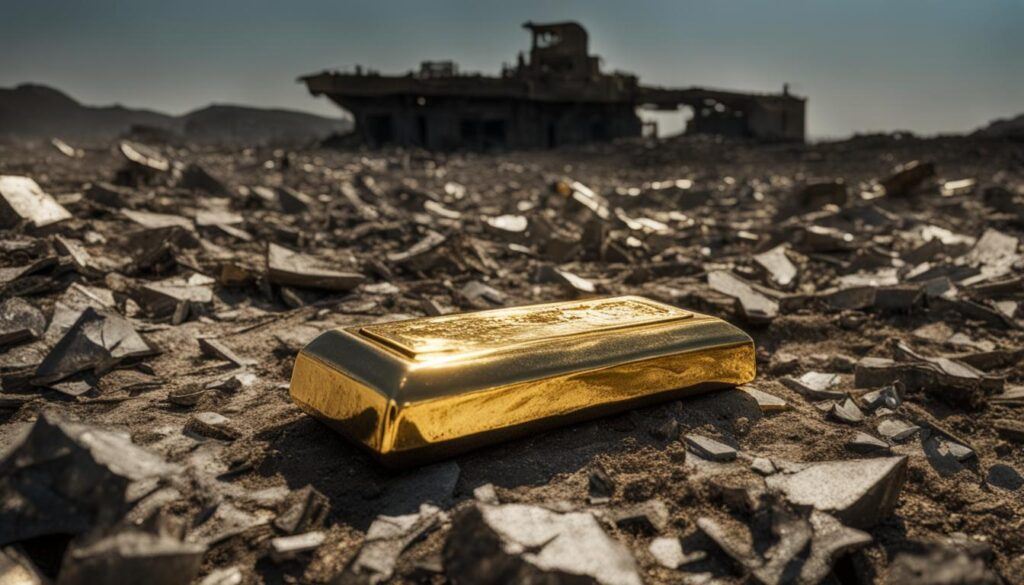
Further Considerations and Controversies
Despite the uncertainties surrounding gold’s survival in a nuclear bomb explosion, there are broader considerations and controversies associated with nuclear weapons and their potential uses. It is crucial to conduct further research and analysis to understand the implications of a large nuclear weapons stockpile, including tactical nuclear weapons.
In recent years, there has been growing concern about the Russian threat and its nuclear capabilities. This has prompted discussions and debates on how to address the potential threats posed by nations like Russia.
The discussion of survival strategies in the face of nuclear conflict extends beyond individual materials like gold. It encompasses a wide range of factors, including geopolitical tensions, diplomacy, military strategies, and public safety measures. The global implications of potential nuclear conflicts are significant, requiring thorough examination and collaboration among nations.
The Role of Further Research:
Further research is essential to uncover a more comprehensive understanding of nuclear weapons stockpiles and their implications. It can provide valuable insights into the effectiveness, dangers, and potential consequences associated with tactical nuclear weapons. By exploring various scenarios and assessing the potential risks, policymakers and strategists can make informed decisions and develop effective strategies to promote global security.
Implications and Policy Considerations:
The existence of large nuclear weapons stockpiles raises significant concerns and has far-reaching implications for global security. It necessitates ongoing diplomatic efforts and open dialogues among nations to reduce the risk of accidental or intentional nuclear conflict. Policy considerations must focus on arms control, non-proliferation initiatives, and disarmament agreements to mitigate the potential threats and foster a more peaceful world.
Survival Strategies and Public Safety:
Given the uncertainties regarding global nuclear threats, it is vital to develop comprehensive survival strategies and prioritize public safety measures. This includes enhancing civil defense systems, ensuring the availability of effective shelters, and promoting public awareness and preparedness. Collaborative efforts between governments, communities, and individuals are crucial for safeguarding lives and minimizing the devastating impacts of nuclear conflict.
Conclusion
The survival of gold in a nuclear bomb explosion is a subject of ongoing speculation and debate. While gold is known for its durability and value, the extreme conditions of a nuclear blast and the subsequent fallout raise legitimate concerns about its resilience. Further research and scientific evidence are necessary to provide conclusive answers about gold’s ability to withstand the destructive forces of a nuclear bomb.
While gold’s physical properties suggest that it could potentially withstand extreme conditions, such as high temperatures and pressure, the intense radiation, shockwaves, and environmental contamination caused by a nuclear blast could still pose significant challenges for gold’s survival. Without concrete scientific evidence, it is difficult to make definitive claims about the ability of gold to endure a nuclear bomb explosion.
It is important to note that the focus on gold’s survival in a nuclear blast should not overshadow the broader discussion around nuclear weapons and their impact. The potential devastation caused by nuclear bombs goes far beyond the survival of any individual material, including gold. It involves complex geopolitical dynamics, international security concerns, and the potential risk of widespread destruction and loss of life.
In conclusion, while gold’s durability makes it a highly valued asset, its ability to withstand a nuclear bomb remains uncertain. Further research and scientific studies are needed to provide concrete evidence and a better understanding of how gold and other materials would fare in the extreme conditions of a nuclear explosion. The ongoing discussion and analysis of nuclear weapons and their impact are of utmost importance in ensuring the safety and security of our world.
FAQ
Can gold survive a nuclear bomb?
While there is limited scientific evidence on the subject, it is worth exploring the resilience of gold in extreme conditions.
What is a salted bomb?
A salted bomb is a type of nuclear weapon designed to produce larger quantities of radioactive fallout than traditional nuclear arms.
How does a salted bomb work?
Salted versions of both fission and fusion weapons can be made by incorporating a material containing an element that can be converted to a highly radioactive isotope through neutron bombardment.
What is a cobalt bomb?
A cobalt bomb is a type of salted bomb that uses cobalt as the radioactive material.
How does a cobalt bomb function?
When a cobalt bomb detonates, the cobalt is transmuted into radioactive cobalt-60, which is then vaporized and deposited by the explosion.
What are the effects of a nuclear bomb explosion?
A nuclear bomb explosion consists of several stages, including an ignition phase marked by a sudden flash of intense brightness and a blast wave that destroys or damages structures within a certain radius.
How can someone survive a nuclear bomb explosion?
To increase the chances of survival, individuals must seek cover during the blast wave phase and then protect themselves from radioactive fallout by staying indoors or in nearby intact buildings and following decontamination procedures.
What is fallout?
Fallout refers to the cloud of toxic radioactive particles that is uplifted during a nuclear bomb explosion and then deposited by the wind, contaminating everything in its path.
How can someone protect themselves from fallout?
Sheltering in place, blocking doors and windows, and using personal protective equipment (PPE) can help create a protected environment.
How does decontamination work?
Decontamination involves thorough scrubbing and changing into clean clothing to remove any radioactive particles from the skin, nails, and hair.
Is there scientific evidence on gold’s ability to survive a nuclear bomb?
While gold is often considered a durable and highly valued metal, there is a lack of scientific evidence specifically addressing its survival in a nuclear bomb explosion.
What are the broader considerations and controversies related to nuclear weapons?
The discussion of survival strategies in the face of nuclear conflict extends beyond individual materials like gold and has significant global implications, including the potential threats posed by nations such as Russia.

